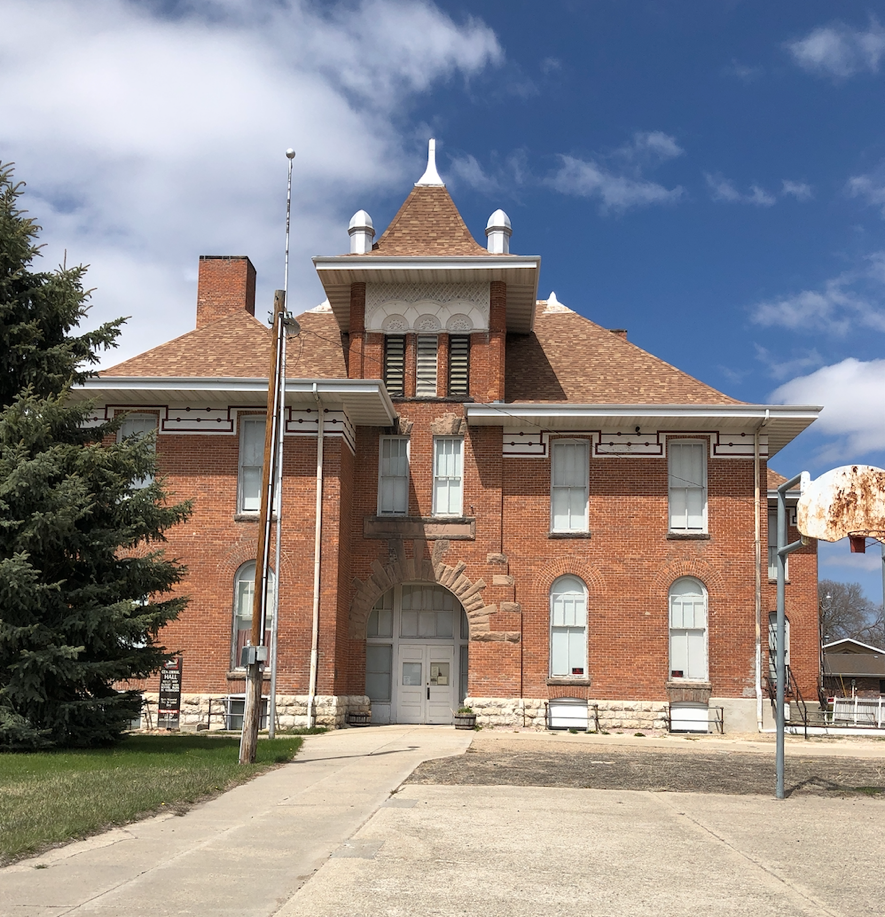by Jan Knispel
Slowly you enter the double doors of this old building and step up the stairs where numerous students have stepped before. You stand and listen, carefully. Even though it is daylight, you can’t help but recall the story of a young girl being murdered in the high school and the rumor that her faint music wafts through these 135 years old hallways.
Why are we here?
In the north central sandhills, sits the oldest standing high school building in Nebraska. Built in Valentine in 1897, Centennial Hall, a building on the National Historic Register, is now a museum of twelve rooms with intriguing exhibits: from the toy room, the schoolroom, the military room, the bell room, and the trophy room, with others as well. Plus, the legend of a ghostly murder victim that has resulted in several paranormal explorations.
Centennial Hall was the location of a yearly fall writing marathon for my dual credit senior/ college composition course. This writing marathon focused on place-based writing. Students in the Valentine schools first visit this museum/historical site as fifth or sixth graders.
But our purpose was to encompass this place as a part of the students’ community and allow them to see the items there as more than antiques with no purpose in their lives. Students would share their new understanding in writing.
Place-based writing develops an appreciation of location, its history and relevance to those who live/lived there. In her essay “I Belong to This Place: Claiming a Neighborhood Landmark,” Leslie Walker states “…who we are is based on who was here before us…. Where we’ve been does matter. Our lives are fashioned by where our families are from, what neighborhoods we live in, and where we call home” (74). This was the goal of the Valentine High School writing marathon.
Preceding this place-based experience, students in this dual credit course were introduced to writing groups, the logistics of writing groups, constructive criticism, the “messy” first draft, multiple drafts, the steps of the writing marathon, and its purpose for our classroom.
Before the Centennial Hall writing marathon took place, students were introduced to the writing marathon instructions used by the Louisiana Writing Project and the Nebraska Writing Project at its marathons and board of directors’ annual summer retreat. (See references)
Essential to the marathon:
- declaring oneself a writer
- respecting the group
- respecting writing time limits,
- accepting the writer’s sharing without expressing criticism.
Additionally, students participated in a short writing marathon in and outside our high school building and (with permission) the neighboring elementary school’s playground and practiced the writing marathon guidelines. These marathons were conducted during each section’s class period time limit.
With this introduction to place-based writing, students were eager to approach the museum exhibits and create new writing pieces contrasted with their elementary school memories.
So, how did it work?
(See logistic suggestions here.)
Students were required to develop one piece through multiple drafts from the short marathon, and three pieces from the Centennial Hall writing marathon. Students were to turn in their writing notebooks for the 12 rooms visited along with all drafts of the four pieces required.
Students could write in any genre they preferred.
Writing sessions were 30 minutes: 15 for writing, 10 for sharing, 5 for moving to the next room.
We wrote all morning, broke for lunch at 12:30, wrote until 2:30 and began our return to school at 3:20. This seems like a lengthy time for students to be writing; however, all students who participated enjoyed being able to write without parameters other than time.
Large group share took place at lunch and from 2:30 to 3:20. Each student was expected to share but no one was forced. Students could pass that day and share pieces in their class section the next day. The reason for this was that some students may have very emotional experiences during their writing time and might not have been comfortable sharing to the whole entire group of 60.
RESULTS:
Students were amazed at what they could remember or had forgotten about their first experience in this place. Many wrote about the contrast and emotions that were invoked.
Some students chose to write about the supposed murder of the girl who died from a poisoned reed on her clarinet and whether they believed this story. Many wrote about the paranormal explorations that have occurred in the Hall or wrote a fictional account of that. (I have yet to find any evidence/proof of this situation which supposedly occurred in the 1940’s.)
The military room evoked student writing about their perspective on the military, their family’s military history, and local history. In several instances, students were surprised to find that items that referred to their families, many of whom first came here in the late 1880s. Those students later interviewed family members to add to their marathon pieces.
Other students reminisced about their childhood in the Toy Room or how much education and schools have changed after visiting the Schoolroom.
Two other rooms that engendered emotional pieces were the Bell Room where a collection of over 1100 bells exist. Many wrote about their own personal collections, what would happen to those, or about an item that was passed to them from a family member.
Another room that stirred many emotions was the Trophy Room. Here we found photos of teams and individuals, and the letter jackets and trophies of teams long past. Again, students wrote of family members’ stories of glory or contemplated their current “glory days’ and how those might be remembered.
Every community has its historical locations, interesting buildings, parks, and recreation sites. Taking your students on a marathon can evoke an appreciation of their own history, and the place they call home.
Work Cited:
Walker, Leslie. “I Belong to This Place: Claiming a Neighborhood Landmark.” Writing America: Classroom Literacy and Public Engagement, edited by Sarah Robbins and Mimi Dyer, Teachers College Columbia University, 2005,
References suggested:
Brooke, Robert, ed. Rural voices: Place-conscious education and the teaching of writing. Vol. 25. Teachers College Press, 2003.
Cherry County Tourism. “Visit Valentine: Centennial Hall Museum.” 2022 https://visitvalentine.org/places/centennial-hall-museum/ accessed March 13, 2022.
The National Writing Project at https://writeout.nwp.org/about-2/place-based-writing/
Teaching the Hudson Valley at https://www.teachingthehudsonvalley.org/place-based-writing-resources/ Accessed March 12, 2022.
Writing America: Classroom Literacy and Public Engagement, edited by Sarah Robbins and Mimi Dyer, Teachers College Columbia University, 2005.



